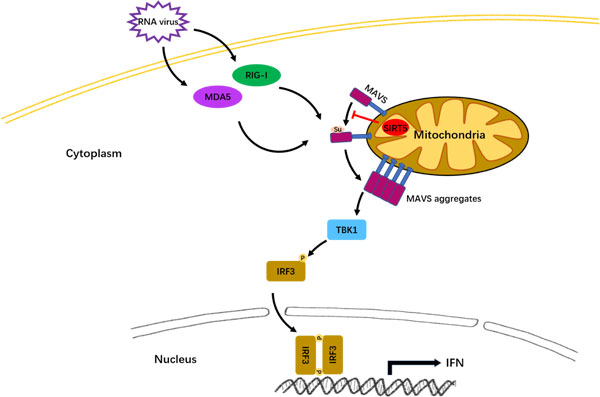
Newsroom
Researchers Reveal Function and Mechanism of Desuccinylase SIRT5 in Antiviral Innate Immunity
Protein succinylation is one of the post-translational modifications of proteins identified recently. However, it is still not clear about its biochemical process and the effects on its target proteins. Given that the intermediates of cell metabolism can directly cause succinylation of proteins, the succinylation/desuccinylation modification of proteins provides a connection between cell metabolism and some biological processes.
To further reveal this connection will help researchers get a clue between metabolism and some biological processes, including anti-virus immunity, metabolic disorders, tumorigenesis, etc.
Sirtuin 5 (SIRT5) belongs to the sirtuin family, which are NAD+-dependent deacetylases. However, the deacetylase activity of SIRT5 is barely detected. It is found that SIRT5 can catalyze desuccinylation of its target proteins.
During screening antiviral genes in fish, XIAO Wuhan’s Lab at Institute of Hydrobiology (IHB) of Chinese Academy of Sciences identified that sirt5 negatively regulates antiviral innate immunity. By taking advantage of cell culture system and mouse model, they demonstrated the function and molecular mechanisms of SIRT5 in anti-viral innate immunity.
Retinoic acid-inducible gene-I (RIG-I)-like receptors (RLRs)-mediated type I interferon (IFN) production plays a pivotal role in innate antiviral immune responses, where the signaling adaptor MAVS is a critical determinant.
Xiao’s Lab found that SIRT5 suppresses the MAVS-mediated type I IFN signaling. SIRT5 co-localizes and interacts with MAVS in the mitochondria. MAVS is succinylated at lysine 7 upon viral challenge, and SIRT5 catalyzes desuccinylation of MAVS. SIRT5-catalyzed desuccinylation of MAVS diminishes the formation of MAVS aggregation, resulting in the impairment of type I IFN production and antiviral gene expression.
Furthermore, they found that Sirt5-deficient mice are resistant to viral infection.
This study revealed the function of SIRT5 in antiviral innate immunity and the underlying mechanisms. In addition, this work also provides a candidate gene for cultivating new fish strains with disease-resistance.
